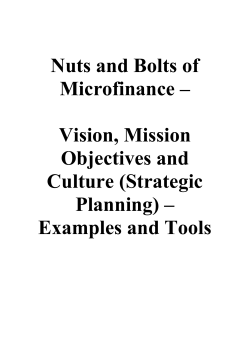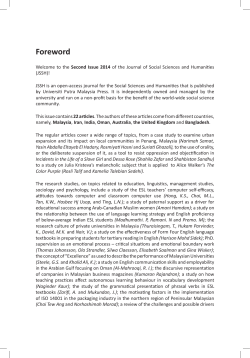
PRESENTED BY: MRS. SHERRY KATWAROO-RAGBIR
PRESENTED BY: MRS. SHERRY KATWAROO-RAGBIR 4th Biennial International Business, Banking & Finance Conference JUNE 22ND – JUNE 24TH In this paper global approaches to microfinance regulation were critically studied in order to formulate policy recommendations for the introduction of microfinance regulation in the Caribbean region. The paper seeks to emphasize the need for an appropriate regulatory framework: to support stable expansion of the regional industry to protect the vulnerable client base to deliver on expected social and economic objectives Features of Microfinance (Basel Committee 2010). Provision of financial services ◦ Services provided include loans, savings, money transfers and microinsurance In limited amounts Target is low-income persons and small businesses Clients generally shunned from the commercial banking sector because of their unfortunate economic status Consultative Group to Assist the Poor (CGAP)2003 - guidelines on regulation and supervision of microfinance: Regulation – binding rules governing the conduct of legal entities and individuals, whether they are adopted by a legislative body (laws) or an executive body (regulations). Prudential financial regulation serves the following macroeconomic goals (Wright 2000) 1. Ensuring the solvency and financial soundness of all financial institutions. 2. Providing depositors protection against excessive risks that may arise from failure, fraud or opportunistic behaviour on the part of the financial institution. 3. Promoting efficient performance of financial intermediaries and markets. Non-prudential regulation & supervision - span a wide spectrum and include: ◦ reporting and disclosure requirements; ‘fit and proper’ requirements for directors and officers; restrictions on interest or deposit rates, setting up of credit information services and preventing fraud and financial crimes. (Microfinance Gateway 2011). Applies not only to licensed financial institutions but also to registered financial service providers. Wright (2000) discussed the following options for microfinance regulation ◦ No External Regulation ◦ Self-Regulation ◦ Blended approach: a mix of self-regulation and part supervision by a third party ◦ Regulation through the existing legal and regulatory framework: Banco Sol - Bolivia ◦ Regulation through MFI-specific regulation: Grameen Bank - Bangladesh Microfinance is fundamentally different from traditional banking and regulation must be built on an understanding of these. Self Regulation is ineffective - does little more than improve the financial reporting and internal controls in the organization Protection of the Poor: in the pursuit of profit-maximization, actions by MFIs and their investors can disadvantage clients. ◦ e.g. Compartamos in Mexico, investors earned a return of roughly 100 percent a year compounded over eight years as Compartamos charges interest rates that exceed 100 percent per year on loans to the poor. Increased transparency is required to provide greater client protection, in areas such as interest rate reporting. Table I: Growth in Demand and Supply of Microfinance Services from 1997 to 2007 Number of Programs Total Number of Clients Number of Poorest Clients Reporting Reached Reported 12/31/97 618 institutions 13,478,797 7,600,000 12/31/98 925 institutions 20,938,899 12,221,918 12/31/99 1,065 institutions 23,555,689 13,779,872 12/31/00 1,567 institutions 30,681,107 19,327,451 12/31/01 2,186 institutions 54,932,235 26,878,332 12/31/02 2,572 institutions 67,606,080 41,594,778 12/31/03 2,931 institutions 80,868,343 54,785,433 12/31/04 3,164 institutions 92,270,289 66,614,871 12/31/05 3,133 institutions 113,261,390 81,949,036 12/31/06 3,316 institutions 133,030,913 92,922,574 12/31/07 3,552 institutions 154,825,825 106,584,679 Date Source: (Daley-Harris 2009) 50% 40% 30% 20% 2000 10% 2009 0% Bank Credit Union Non-Bank NGO Rural Bank Financial Institution Figure1: Percentage Composition of MFIs by Institution type as at Dec 31st 2000 and 2009 Commercial Microfinance To enable sustained growth many MFIs are opting to transform from a nonprofit status to registered and regulated financial institutions, with start-up MFIs generally opting for regulated status. Benefits of the licensed NBFI over the NGO: Access to additional sources of funds - NGOs’ sources of funds are limited to donations, income from lending and subsidized loans. Regulated MFIs can access commercial sources of funds for both equity and debt. Wider range of financial services – including but not limited to savings mobilization, this gives the MFI access to a stable source of local resources, and enables expanded outreach. Prudential regulation to protect depositors and guard against moral hazard is critical. Self Sustainability and Profitability – 2007 MicroBanking Bulletin 2005 Benchmarking Exercise Median Institutions’ Commercial Funding % 60% Increase in commercial borrowing from 2003 to 2005 US$1 billion Portion of Increase to Regulated MFIs > 50% Wenner and Chalmers (2001) Caribbean microfinance suffers from substandard financial performance and lacks outreach into the microenterprise sector when compared to Asia and Latin America. Westley (2005) To date most programs are financially unsustainable and remain dependant on government or donor-supported funding. The Economist Intelligence Unit (2009) conducted a study which ranked fifty-five countries worldwide based on each country’s regulatory, investment and institutional environment for microfinance. The only two Caribbean countries in the study were Jamaica and Trinidad. Both countries ranked in the top twenty for investment climate Under institutional development Trinidad ranked forty with a score of 16.7 out of 100, and Jamaica ranked fifty-second with a score of 8.3. Under the regulatory framework dimension, Jamaica scored 25 out of 100 and ranked fifty and Trinidad came in last at fifty-five with a score of 12.5. Players in the industry are: ◦ specialized financial institutions, state owned and funded companies, credit unions and donor supported NGOs. Primary focus of Caribbean MFIs is the provision of funding to small entrepreneurs and microenterprises (Lashley and Lord 2002) Mainly the NGO type institutions have focussed directly on reaching those disenfranchised and excluded from participation in the traditional banking sector, explaining the continued importance of this business type in regional and global microfinancing. Constraints to the Growth of the Microfinance Sector in the Caribbean: Wenner and Chalmers (2001) in comparing Caribbean and Latin American MFIs associate a number of limiting factors for Caribbean microfinance. …. the smaller and more concentrated financial markets, the greater degree of macroeconomic stability, lower rates of poverty and superior standard of living, the prevalence of inappropriate lending technologies... Poor re-payment culture of Caribbean borrowers. Lashley and Lord (2002) commented that clients generally take loans as handouts never to be re-paid. Caribbean MFIs operate in an environment of fixed interest rates. These rates are set too low to allow MFIs to profitably cover their high operating costs or to take advantage of their clients’ willingness to pay higher than market rates. Divergence between the goals of government and private MFIs leading to market inefficiencies: ◦ Many government initiatives designed to ease the conditions of the poor create a dependency syndrome that can suppress entrepreneurial spirit among those for whom microfinance is available. ◦ State owned and funded MFIs use state funds to compete with well-established private MFIs that fund their operations from commercial sources. Wenner (2005) points out that these state funded programs lend at lower interest rates and are not as aggressive in ensuring portfolio quality or enforcing debt recovery. Where to Start? Gain a comprehensive understanding of the present state of the microfinance industry. Role of Government: 1. 2. Clearly articulate the role of microfinance in the financial sector and in social development. These goals should be complimentary Counts and Sobhan (2002) – recommends a government appointed “Microfinance Commission” to create a supportive regulatory environment for microfinance ◦ Consist of wide representation of knowledgeable members and be representative of donors, government, NGOs, academia and the private sector. A phased approach focussing on critical priority areas: Clear distinctions must be drawn between the various types of MFIs. A tiered approach where different classes of institutions are subject to differing levels of regulation can be applied. Regulations should be updated for the Non Bank Financial Institutions NBFIs. ◦ Liquidity requirements should be tightened if MFIs are to intermediate deposits. ◦ Reserve requirements should however be less onerous than the traditional banks. Increased transparency on interest rates charged should replace fixed interest rates. ◦ Standardize the methods to calculate and communicate interest rate charges to borrowers and the public (Counts and Sobhan 2002). Mitigations: Christen et al. (2003) warn that regulation that is not enforced can be worst than no regulation at all, build adequate supervisory capability. Resist the temptation to copy what other nations have done. Over-regulation must be guarded against as this can shut down rather than promote development in the sector. Realism must be maintained at all times. Regulation alone will not lead to sustainable growth in the microfinance sector. It must be enacted together with other enabling policies such as institutional rationalization and development.
© Copyright 2025





















